Invasive Species

What are invasive species?
Invasive species are plants and animals which occur outside their natural range and can have significant ecological, social and/or economic impacts once established. As an urban municipality bound by the Fraser River, Richmond is particularly vulnerable to the introduction and spread of invasive species.
Learn more, report and take action on invasive species.
New! Private property treatments for knotweed species and giant hogweed
The City is launching a multi-year program to help control knotweed and giant hogweed on private properties. Through a coordinated treatment approach, property owners can participate in a City-funded program to effectively manage these invasive species. This initiative aims to improve treatment efficiency, prevent the spread, and support healthier ecosystems.
For more information, or to find out if you are eligible, visit LetsTalkRichmond.ca/InvasiveSpecies.
Invasive Species Action Plan
Over two dozen invasive plants, animals and insects have been detected in Richmond. This includes several high risk species such as:
- Knotweed, which can grow through asphalt
- Parrot’s feather, which impacts the storm drain system
- Fire ants, who can cause a painful sting and render infested lawns impassable
- Giant hogweed which can cause severe skin burns
Invasive Species Management Plan
The City of Richmond has taken a practical approach to managing invasive species and continues to be on the forefront in efforts to detect and rapidly respond to newly arrived invasive species. Utilizing the City’s Enhanced Pesticide Management Program, the invasive species management approach in Richmond has produced many noteworthy accomplishments.
To avoid damage to infrastructure, ecology, human health, and the economy, the City has been proactively addressing invasive species on City lands. The City’s Invasive Species Action Plan is a strategic and risk-based approach to guide and prioritize invasive species management into the future. The Plan provides guidance on setting priorities, establishing a consistent approach, and delivering public outreach and engagement.
2023 Invasive Species Action Plan Update
2021 Invasive Species Action Plan Update
2017 Invasive Species Action Plan Update
Priority Invasive Species in Richmond
The following species are recognized as priority species within the City of Richmond:
Brazilian Elodea
Brazilian Elodea - Provincial EDRR Species (Egeria densa)
Brazilian elodea is the most aggressive aquatic aquarium trade plant species globally and it is recognized under the Province’s Early Detection Rapid Response program. At this time, the infestation is localized to one area. It was likely released into Richmond’s drainage system from an unwanted aquarium. It forms dense mats up to 4 metres deep in still and flowing water sources.
Description and Identification
Brazilian elodea is easily confused with other similar-looking aquatic plants. It is usually submerged, but can form dense mats on the surface of water. Leaves grow in whorls around the plants stem, making it appear very leafy. In the spring and summer, Brazilian elodea blooms with small, white, three-petal flowers that float on top of the water or slightly above.
Impacts on the Environment
Brazilian elodea impacts aquatic ecosystems by forming dense mat canopies that shade out native vegetation. It can restrict water movement and alter the chemical and physical characteristics of the ecosystem, which can decrease local biodiversity. Brazilian elodea can also have negative economic impacts, as it clogs rivers and drainage canals which then require constant maintenance and attention. In ponds and rivers it makes recreational activities such as fishing, swimming and boating difficult or impossible. It impedes flood capacity and storm drain systems which increases municipal maintenance costs.
City Efforts
The City of Richmond has partnered with the Province of BC, to manage a large infestation of Brazilian elodea within a water feature near the West Dike since 2014. There are currently only two confirmed sites of Brazilian elodea in waterbodies in BC. Its presence in BC is particularly concerning due to the plant’s extreme ability to regenerate.
There are currently no formal best management practices in BC to manage infestations. With support from the Province, the City implemented an integrated pest management approach to managing Brazilian elodea in 2017. Primary management activities to control the infestation have included:
- Creating and preparing community engagement material and raising awareness of the program through local meeting with the public
- Containment using mechanical suction dredging and nets
- Designing, constructing and installing a project-specific weir system to control water levels in the drainage canal
- Completing geo-spatial inventories to monitor regeneration
- Controlling water levels each season during winter months to expose elodea and its roots to freezing temperatures
- Manipulating the exposed soils to further expose and stress the plant roots
- Removing biomass from the water column with specialized, custom-built diver-assisted suction dredge equipment never utilized in the Lower Mainland at the time
- To date, the integrated management approach has successfully reduced the infestation completely, and no regrowth has been observed since 2021. In addition, the soil manipulation has acted to naturalize the area and the City has noted a resurgence of native vegetation and wildlife back to the area.
Common Reed
Common reed (Provincial EDDR species) is a perennial grass that can grow between 2-5 meters tall with feather like flower clusters ranging from 15-35cm long. It is found in freshwater, brackish tidal wetlands, coastal shorelines, wetlands, sloughs, canals, ponds, ditches and watercourses.
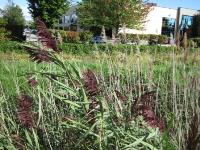 It is easily confused with native subspecies (Phragmites australis spp. americanus) which is found in the lower Fraser Valley. Identity must be confirmed by an expert and samples can be sent to the Provincial Early Detection and Rapid Response coordinator. It reproduces by seed and root fragments which can be carried in water, contaminated soil and on vehicles and equipment. Any mowing or roadside maintenance will lead to spread.
It is easily confused with native subspecies (Phragmites australis spp. americanus) which is found in the lower Fraser Valley. Identity must be confirmed by an expert and samples can be sent to the Provincial Early Detection and Rapid Response coordinator. It reproduces by seed and root fragments which can be carried in water, contaminated soil and on vehicles and equipment. Any mowing or roadside maintenance will lead to spread.
Impacts on the Environment
Common reed alters the hydrology of water flow which can impact the City’s ditches and watercourses, and causes safety hazards by obstructing driver’s sight lines. As a threat to aquatic ecosystems, common reed has the potential to spread into agriculturally productive croplands such as blueberry and cranberry fields. It can impact wetlands by displacing native vegetation and reducing habitat for wildlife.
Removal and Control
Common reed is a provincially listed Early Detection, Rapid Response noxious weed. If you think you may have common reed, contact the City of Richmond for guidance on proper identification.
City Efforts
The Richmond site was the first confirmed common reed site in BC. The Early Detection and Rapid Response partnership with the province resulted in the full containment and control of this infestation due to the City's prompt response.
Eurasian Water-milfoil
Eurasian water-milfoil (Myriophyllum spicatum) is an aquatic invasive plant found submerged in still or slow moving freshwater streams, canals, and lakes. It has tiny reddish flowers that grow on spikes 5-20 cm long that rise above the water. It reproduces by seed, root and plant fragments which can be carried in water, on vehicles, and on equipment.
Eurasian water-milfoil can affect the City’s infrastructure by impeding flood control, storm drain systems, and irrigation works. It restricts water movement, and traps sediments, which increase municipal costs. Ecologically, Eurasian water-milfoil displaces native aquatic vegetation, subsequently altering the aquatic habitats and food webs.
Learn More
For more information, view the Invasive Species Council of BC's online resources.
European & Impressive Fire Ants
What are European Fire Ants?
The European fire ant (Myrmica rubra) is native to Europe and Asia and was first introduced to eastern North America in the 1900s. Fire ants were first recorded in B.C. in 2010, and have since been discovered in isolated locations throughout the Lower Mainland.
Fire Ant Characteristics
It is important to note that there are many species of ants, including red ones, which are native to our region. Please do not assume that any red ant you see is a European fire ant. European fire ants can be very difficult to identify, even for a trained eye with a hand lens. For help identifying, please refer to a fire ant expert.
Fire ants have the following distinct characteristics:
- Small in size and red in colour
- Constricted "waist" has two segments (most native species have only one)
- Two backward-point spines on the middle body section, visible only with a magnifying glass
- Nests are built in soil under rocks, wood or other debris (nests are not large soil mounds)
- Usually very abundant, with 10–12 nests in a 10" by 10" area
The fire ant is capable of inflicting a painful, burning sting. Reaction to their sting varies, though typically people experience a burning sensation and the bite area will inflame and remain sore for a few hours or days. If you experience a strong reaction, call Healthlink BC at 8-1-1 for symptom advice.
Why are fire ants a problem?
The European fire ant is an aggressive, swarming ant that can deliver a painful sting when disturbed by people, pets and wildlife that wander into their territory. If a colony moves into a park, they may impact the recreational use of the park, and may also threaten native ants in the area.
What can residents do to reduce the spread of fire ants?
The following are the steps you can take to help ensure that fire ants do not spread throughout Richmond:
- Inspect all your purchased plants, soil and wood materials for ants or other insects.
- Do not purchase anything that carries insects, weeds or other foreign material that you are not familiar with, or feel does not belong on the product you are purchasing.
- Report any findings directly to the retail manager to help them investigate their inventory.
- Do not share plants or garden materials, including compost, that carry ants, insects or weeds with them.
- Learn about the European fire ant and how to properly control the species. Improper control techniques will cause a fire ant infestation to spread and worsen.
How can we get rid of fire ants?
Once established, European fire ants can be a very difficult pest to manage, and insecticides/pesticides do not work on this type of ant at this time. If you suspect that you have an infestation of fire ants on your property, the first thing you should do is confirm their identity.
How to collect and send samples.
Baiting
While there is no certain way to eradicate the fire ant, baits appear to offer some limited promise.
Fire Ant Deterrents
This ant loves moisture. It likes tall grass, well irrigated lawns, raised garden beds, and the ground under lawn clutter (e.g. children's play structures, stored BBQ tanks, etc). Minimizing watering and keeping your property clutter-free may help prevent the spread of the ant.
It also likes heat, which can come from paving stones, ornamental stones and landscaping wood. These items warm during the day and hold that heat overnight, making them a better nesting site than open areas. Consider placing gravel immediately behind landscaping ties for the same purpose.
Coordinated Community Approach
Coordinate with your neighbours. One homeowner working alone is unlikely to see results, as new ant colonies will invade from adjacent properties. Talk to your neighbours about the coordinated use of baits.
Learn More
European Chafer Beetle
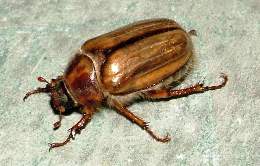 The European chafer beetle (Rhizotrogus majalis) is an introduced insect to BC that has become a serious lawn pest in the Lower Mainland. The chafer larvae (grubs) damage lawns and boulevards by feeding on the roots of turf grass, resulting in the appearance of brown (dead) grass patches in affected lawns. The major damage to lawns occurs when crows, skunks and other animals dig up the lawn in search of these large, white grubs that occur in early spring and fall. Adult beetles don’t cause any significant damage. They are short-lived and do not bite or sting.
The European chafer beetle (Rhizotrogus majalis) is an introduced insect to BC that has become a serious lawn pest in the Lower Mainland. The chafer larvae (grubs) damage lawns and boulevards by feeding on the roots of turf grass, resulting in the appearance of brown (dead) grass patches in affected lawns. The major damage to lawns occurs when crows, skunks and other animals dig up the lawn in search of these large, white grubs that occur in early spring and fall. Adult beetles don’t cause any significant damage. They are short-lived and do not bite or sting.
Description and Identification
Adult European chafers are tan or brown beetles resembling June beetles and measure approximately 1.5cm in length. The grubs measure approximately 2 to 2.5cm, are soft, white and C-shaped with tan-coloured heads and six prominent legs.
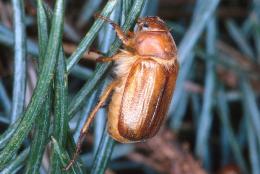 |
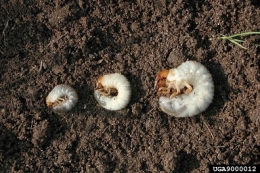 |
| Adult European Chafer | European Chafer Larvae ( White Grubs) |
Infested lawns may feel "spongy" due to the grubs tunnelling below. Turf will commonly be wilted or dead and easy to pull back, revealing the feeding larvae. Damage is seen in the fall to early spring when the grubs are full-grown. You may also see birds, skunks, and other animals digging up your lawn in search of grubs.
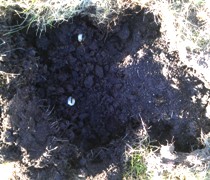 To monitor the presence of chafer grubs in your lawn, cut a 30 by 30cm square of sod, and fold it back to count the grubs underneath. Cut 5 sections per lawn. Search through the soil beneath the grass and count the number of grubs. If more than 5-10 grubs are found per section, chafer control is recommended.
To monitor the presence of chafer grubs in your lawn, cut a 30 by 30cm square of sod, and fold it back to count the grubs underneath. Cut 5 sections per lawn. Search through the soil beneath the grass and count the number of grubs. If more than 5-10 grubs are found per section, chafer control is recommended.
Biology and Life Cycle
Chafers complete their life cycle in one year which can lead to rapid population increases. Adult beetles emerge from the soil in June and mate in swarms at dusk. In July, females lay up to 20 to 30 eggs in the soil. The eggs hatch in about 2 weeks and the small grubs begin to feed on the grass roots. Infested turf will usually be wilted or dead and easy to pull back, revealing the feeding larvae. Damage is typically seen in the fall to early spring when the grubs are full-grown. Feeding continues throughout the winter until they pupate in May, except during prolonged periods of freezing temperatures. European Chafer Illustrated Life cycle
Management and Control
Minimize lawn damage caused by chafer grubs by keeping your turf healthy and thick with proper lawn care practices:
- Increase mowing height to 8-10 cm (3-4 in). Longer grass blades mean a longer root system that is more resilient to the larvae feeding.
- Fertilize regularly by top dressing twice a year with compost or by using organic, slow-release fertilizers. Leaving grass clippings on the lawn, rather than bagging and disposing of them (grasscyling), also naturally fertilizes your lawn with nutrients after each mow.
- Water your lawn deeply: 2 to 3 cm (½ to 1 inch) once a week to promote a lush lawn with deep roots that better resist insect damage and drought. Follow the water use restrictions in effect from May 1 to October 15.
- Overseed your lawn annually with a grass seed mix will contribute to maintain a dense, healthy, and weed-free lawn.
- Lime your lawn in fall and spring to counteract the soil’s natural acidity. Acidic soil prevents grass from taking up key nutrients necessary for its optimal growth and health.
Use barriers
Even if the grass is dead, some residents opt to cover the affected areas of their lawns, with netting, fencing or chicken wire, to prevent further damage to the turf from foraging animals.
Reduce exterior lighting
Chafer beetles are attracted to light when mating. Reducing exterior lighting on your property, particularly during the egg-laying season in June and July, can help reduce the number of grubs in your lawn.
Alternative groundcovers
Another option is to replace infested lawns with other low-maintenance ground-cover plants such as kinnikinnick, salal, creeping thyme, ornamental grasses, Dutch white clover or other sustainable turf alternatives.
Apply nematodes during the third week of July
The application of nematodes has proven to be the most effective approach in managing the European chafer. Nematodes are naturally-occurring microscopic roundworms, which move through wet soil seeking out the chafer. They are not dangerous to humans, animals or to the environment. Products containing the Heterorhabditis bacteriophora nematodes for chafer control are available at local garden supply stores. Check product packaging to make sure it contains this type of nematode, as there are other nematode species sold for other pests.
Nematodes are most effective when applied from mid to the end of July when chafer larvae are small and most vulnerable to nematode infection. Check with your local garden centre as some require advanced ordering for the nematodes in the spring.
Water Exemption Permits
A Water Use Exemption Permit for nematode application is only issued during Stage 1 water restrictions. Permits issued under Stage 1 water restrictions will remain valid under Stage 2 water restrictions within the permits validity period. All permits expire immediately if Stage 3 or 4 water restrictions are declared. Permits are available online here.For a successful nematode application:
The application area must be well irrigated before nematode application to prevent dry soil in the root zone. It is recommended to irrigate for 2 hours preceding the application.
- Mix and apply product according to label directions and preferably apply in the evening or on a cloudy day to maximize success.
- Irrigate again for 2 hours after the application and continue to irrigate twice per week for 3 weeks. A watering permit allowing you to sprinkle outside the restricted times will be required. Permits are now available online. Please call 604-276-4000 if you require more information.
Chemical Insecticides
Because of their biology, the effectiveness of chemical pesticides is limited on chafer grubs.
Currently, there are no insecticides for use on chafer allowed under the City’s Pesticide Use Control Bylaw No. 8514. Check the pesticide list on the Bylaw's Schedule A: Excluded Pesticides for permitted pesticide products in Richmond.
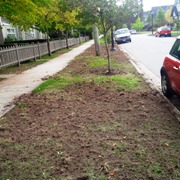 Lawn Restoration
Lawn Restoration
Removal of soil from a site infested with chafer grubs is not recommended, as this may accelerate the spread of the European chafer grubs in the region. To repair damaged lawns:
- Lightly rake over damaged turf areas to remove the thatch and debris.
- Top dress with 1-2 cm of compost or lawn topdressing soil mix.
- Reseed abundantly the damaged lawn areas.
- Lightly rake seeded area for good seed/soil contact.
- Water the seeded area frequently ensuring that it remains moist until 50% of the seeds have germinated.
Boulevards
On boulevards immediately fronting an owner’s property, under the City’s Boulevard Maintenance Regulation Bylaw No.7174, the property owner is responsible for the maintenance of turf grass.
Learn More
- Visit our Natural Yard and Garden Care section for upcoming Educational workshops.
- European chafer beetle brochure
Giant Hogweed
Giant Hogweed (Heracleum mantegazzianum) is an invasive plant rarely found in Richmond. This hazardous plant poses a serious threat to human health and to our natural ecosystem. Contact with sap from the stem, hairs and leaves can cause severe burns and blisters on the skin, while contact with the eyes can cause temporary or permanent vision problems.
Description & Identification
Giant Hogweed is an unusually large plant, growing from 1.5 to 5 meters tall, with meter wide, umbrella like, clusters of small white flowers. The leaves are up to 3 metres wide, with very coarse and serrated edges, like a jagged saw. The stem is hollow with dark red or purple spots. It can be found in any area with moist soil, including vacant lots, natural areas, riverbanks, roadways, and also on residential properties.
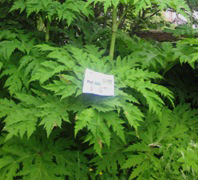 |
Mature hogweed leaf size compared to 8"x11" sheet of paper |
National Fact Sheet
Giant hogweed is easily mistaken for its close relative, cow parsnip (H. maximum), which is native and widespread in Richmond. Cow parsnip ranges in height from 1-3 metres and is generally a smaller plant than giant hogweed. Cow parsnip can also cause mild irritation when sensitive skin types come in contact with the plant. It is a native species to B.C. and is not managed by the City. For a detailed comparison of these two plants, consult the National Fact Sheet on Giant Hogweed provided above.
Health & First Aid
Contact with sap from the stem, hairs and leaves can cause severe burns and blisters on the skin, while contact with the eyes can cause temporary or permanent vision problems.
Anyone who has direct contact with hogweed sap should:
- Wash the affected area immediately with mild soap and cool water,
- Keep exposed skin out of the sunlight, as the toxicity increases with light, and
- Seek immediate medical attention if blistering occurs.
Contact with sap can occur by brushing against any broken plant parts, handling plant material, or even by touching tools or mowing equipment that was used in infested areas. The BC Drug and Poison Information Centre can also be called for more health advice at 604-682-5050 in the Lower Mainland Area, or toll free at 1-800-567-8911.
Impacts on the Environment
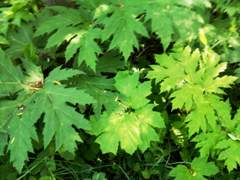 With its enormous size, and prolific seed capacity of up to 100,000 seeds per plant, giant hogweed can spread rapidly and dominate vegetation if not properly managed, reducing the amount of habitat for native plants and wildlife. In public spaces, giant hogweed infestations can prevent access to and lead to the loss of enjoyment of an area. In winter, infested areas are prone to erosion of stream banks by exposing bare soil to frequent coastal rainfall.
With its enormous size, and prolific seed capacity of up to 100,000 seeds per plant, giant hogweed can spread rapidly and dominate vegetation if not properly managed, reducing the amount of habitat for native plants and wildlife. In public spaces, giant hogweed infestations can prevent access to and lead to the loss of enjoyment of an area. In winter, infested areas are prone to erosion of stream banks by exposing bare soil to frequent coastal rainfall.
Removal & Control
Rapid elimination and control is critical to stop the spread of giant hogweed throughout our community.
Be advised that precautions and safety measures are required when removing this plant to avoid exposure to sap and to avoid burns.
The City advises that you do not attempt to remove the plant yourself, but hire a professional and contact the Invasive Species Council of BC at 1-800-WEEDSBC or the Invasive Species of Metro Vancouver at 604- 880-8358 for more information.
If you should choose to remove the plant yourself, wear protective clothing covering all exposed skin and eyes when handling giant hogweed, including rubber gloves, rubberized raingear, and a facemask or safety goggles. Ideally, removal work should proceed on cloudy days.
Removing the flower head in the summer before it turns to seed is another technique to slow the spread of giant hogweed. Once developed, seeds remain viable in the soil for number of years. Monitoring of infested sites and destruction of new seedlings should be expected for the next couple of years, following the removal of mature plants.
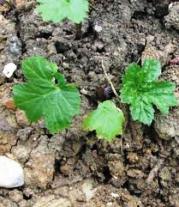 |
|
| Giant hogweed seedlings | |
Reporting Giant Hogweed
The City is actively monitoring public lands for giant hogweed and asking for the community's help to rapidly identify and eliminate new infestations of giant hogweed in Richmond.
For more information or to report giant hogweed:
Phone: 604-276-4316
E-mail: invasiveplants@richmond.ca (if possible, include a picture of the suspected plant for rapid identification).
City Efforts
Known infestations are continually monitored on City lands and promptly treated on a priority basis. City staff gives guidance to private property owners on best management practices and treatment methods.
Learn More
Japanese Beetle
The Canadian Food Inspection Agency (CFIA) has confirmed the detection of Japanese beetle (Popilia japonica) in the City of Richmond in 2022 as one individual beetle was located near City Center. Japanese beetle is a regulated, invasive pest that poses exceptional threat to a wide variety of urban plants and agricultural crops. Adult beetles eat the flowers, foliage, and fruit of more than 300 plant species. Their larvae also feed on the roots of lawns and other plants. The insect is not new to the Metro Vancouver area. Municipalities currently managing active populations of Japanese beetles include Vancouver, Port Coquitlam and Burnaby. The CFIA has established regulated areas in these municipalities to regulate the movement of organic material to reduce risk of spread. A regulated area has not been established in Richmond at this time. Visit the CFIA website for more information on the collective regional response.
What is the City doing?
The City is working collaboratively with Vancouver, Port Coquitlam and Burnaby, senior level government, and industry to prevent further spread and eradicate Japanese beetle.
| How safe is the treatment? The most effective larvacide, Acelepryn, is not harmful to you, your pets, other animals, or pollinators like bees and butterflies. It is applied directly on the soil and targets root-eating grubs. Acelepryn is approved for use in Canada by Health Canada and is permitted under Richmond’s Pesticide Use Control Bylaw No. 8516. |
Treatment The City has been directed by the Province to treat a small area of city-owned boulevards in the City Center area that could be potential breeding sites for Japanese beetle (see below). This method is most effective to control and prevent further spread. Treatment was carried out in May 2023. Notification to surrounding property-owners was delivered directly by the city prior to treatment. |
A map of public land treatment areas is shown below:
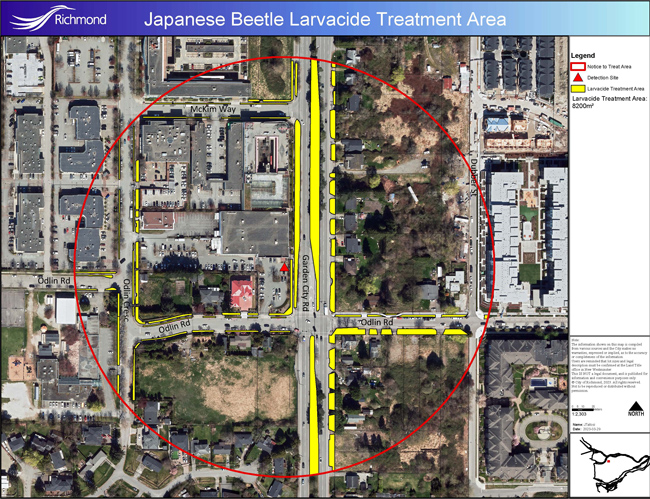
What you can do:
- Speak with your landscaper about the pest and request that they properly clean their equipment if they are moving around the region
- Keep soil and green waste on site (compost!) or use your green bin to dispose of soil and plant waste
- Check your clothes, vehicles and equipment for Japanese beetles, especially when leaving parks, fields, golf courses or other greenspaces. They love hitching a ride!
- Clean your personal yard equipment and tools (lawn mowers, power aerators, etc.) regularly
- If you suspect you have identified a Japanese beetle, please report it to the Invasive Species Council of BC: 1-888-933-3722, or https://bcinvasives.ca/report
Helpful links
- Information on Canadian Food Inspection Agency response
- Beetle education and awareness from Invasive Species Council of BC
- Information on eradication effort, decision to eradicate Japanese beetle, and treatment product being used from BC Ministry of Agriculture
- Details on the impact on landscaping from BC Landscape & Nursery Association
Knotweed Species
Knotweed species (Fallopia japonica, Fallopia x bohemica, Fallopia sachalenensis, and Polygonum polystachyum) are one of the most aggressive invasive plants. They spread by seed, root, and stem fragments carried in water, soil and on vehicles and equipment. Knotweed has the ability to damage crucial infrastructure, including the Richmond dike system. It is capable of growing through cracks in cement, asphalt, house foundations, and walls. Native to eastern Asia, these plants are also often compared to icebergs because the growth above ground is only a fraction of the growth occurring in the root system.
Description and Identification
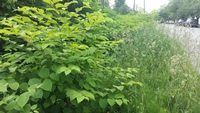 Knotweed can grow up to 3 metres tall. They are bamboo-like in appearance with reddish stems and have large, oval leaves with pointed tips. The flowers of knotweed are creamy-white and bloom in clusters during the late summer and fall.
Knotweed can grow up to 3 metres tall. They are bamboo-like in appearance with reddish stems and have large, oval leaves with pointed tips. The flowers of knotweed are creamy-white and bloom in clusters during the late summer and fall.
Impacts on the Environment
Knotweed species form dense thickets and often out-compete native plant species and decrease local biodiversity. The negative economic impact of knotweed is not limited to the damage of important infrastructure such as building foundations. There are also negative economic impacts both through investment in controlling the species, and the containment of the species.
If you find any knotweed species near your home, be sure to have it treated immediately to prevent foundation destabilization.
Removal and Control
The most effective knotweed control method is multiple applications of herbicide. Treatment of knotweed near watercourses is allowed, there are restrictions and best management practices to be followed. Herbicide needs to be applied repeatedly to ensure the roots of the plant are destroyed and will not re-grow. Although not recommended, plants can also be removed mechanically in specific situations by digging out roots as long as care is taken to remove all fragments.
If you have knotweed on your property, cut off the flowers and seed heads and put in a bag in the garbage. Allow knotweed stalks to dry out completely and put into the municipal green waste bin; do not put in a backyard composter.
City Efforts
Under the Invasive Species Action Plan the City is treating priority areas and mapped infestations.
To mitigate spread and ensure best management practices are followed, “Do Not Mow” signs have been installed that ensure City workers avoid mowing the infestations which causes significant spread by fragmentation. As well, the signs have served as an outreach tool for the public to properly identify knotweed infestations.
For more information, view the Invasive Species Council of BC's online resources.
Mosquitos
What is the City Doing?
The City has contracted Morrow BioScience Ltd. to conduct a nuisance mosquito control program in high mosquito density areas throughout the city. This environmentally-sensitive program is designed to reduce nuisance mosquito populations to tolerable levels by aiming to control mosquitoes at the larval stage of the mosquito life cycle.
A regional Mosquito Control Hotline has been established to take calls regarding mosquito nuisance concerns. The program depends on the public to inform when and where they are experiencing concerns about mosquitoes.
To report mosquito-related concerns, call the Mosquito Hotline at 604-432-6228. The phone line, operated by Morrow BioScience Ltd., is available 24 hours a day and all inquiries are responded to within 24 hours of receiving messages.
Larval Mosquito Control
The primary emphasis is to target mosquito larvae confined to a specific location (such as stagnant bodies of water including sloughs, seasonal wetlands, detention ponds, and/or roadside ditches). The program involves:- Surveillance
- Identification
- Data collection
- Monitoring
- Treatment of mosquito-producing sites
When sites meet a population threshold, specific identified surface water is treated with environment-friendly larvicide called Bacillus thuringiensis israelensis (Bti). Bti-coated corn pellets are distributed by hand or backpack spreader via foot or boat access.
Nuisance mosquito species are not typically associated with the spread of West Nile virus.
How Can You Reduce Mosquito Breeding Area Around Your House?
It is important to keep residential or business property free of standing and stagnant water. This helps reduce the number of mosquitoes in your neighbourhood as most mosquitoes fly about one to three kilometres from their breeding site. Follow these simple practices to eliminate mosquito breeding sites on your property.- Old tires should be disposed of or moved inside. Do not let outside containers, equipment, or debris collect water - recycle, drill holes in, or overturn them when not in use.
- Eavestroughs should be kept clean to allow proper water drainage. Flat roofs should be kept free of standing water.
- Storm drains and lawn basins should be kept free of debris such as yard waste, lawn cuttings, and leaves.
- Roof downspouts should be properly designed and maintained to prevent standing water.
- Leaky faucets should be repaired to prevent water build-up or pooling on the ground.
- Windows and attic vents should be adequately screened and maintained to keep mosquitoes out of your home.
- Stagnant water located in birdbaths should be changed weekly. Rain barrels should be covered with fine mesh and wheelbarrows overturned when not in use.
- Ponds should be maintained. Using pumps or fountains to keep water circulating reduces mosquito breeding.
- Swimming pools should have operating chlorine and circulation systems. Wading pools should be overturned when they are not in use.
- Compost should be turned frequently to keep well-aerated.
How Can You Protect Yourself?
Mosquitoes are most active between dusk and dawn. If you are outside in the evening or early morning, minimize your exposure to bites by:- Using mosquito netting to protect infants when in an unscreened structure or when sleeping outdoors.
- Wearing long sleeved shirts and long pants.
- Wearing light-coloured clothing. Mosquitoes are attracted to dark, intense colours.
- Wearing clothing made of tightly woven materials that will keep mosquitoes away from the skin. The use of mesh “bug jackets” or “bug hats” is also recommended during extreme conditions.
- Considering an insect repellent containing DEET or other approved ingredients.
Parrot's Feather
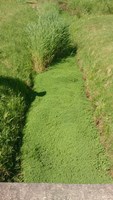
Description and Identification
Parrot’s feather is an aquatic plant found exclusively in waterways. It has submerged growth as well as emergent leaves that form dense mats on the surface of the water, and can cover entire waterways. Emergent leaves are bright green, 2-5 centimetres long and resemble small fir trees or feathers with lots of divisions along the leaf. It is often seen in the City’s drainage canals and sloughs.
Impacts on the Environment
Dense mats of parrot's feather out-compete native species, decreasing local biodiversity. It can cause water to become stagnant, altering the chemical and physical characteristics of the aquatic ecosystem. Parrot’s feather spreads rapidly via fragmentation of leaves and roots. It is important to try not to disturb these plants as every 4 millimetre fragment is capable of floating downstream and establishing a new population.
Parrot’s feather also has negative economic impacts as it clogs Richmond’s drainage canals which then require monitoring and maintenance.
Removal and Control
Control of parrot’s feather is very difficult and there is no perfect solution. Herbicide is not used in the City for parrot’s feather control, and is generally restricted due to availability of effective products. Mechanical removal of parrot’s feather can be used as a last resort due to the risk of fragmentation and spread of plants. Mechanical control is relied on only when infestations become impactful to water flow in Richmond ditches or waterways.
City Efforts 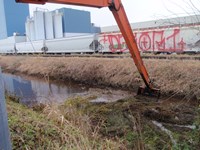
Under the City’s Invasive Species Action Plan, City staff have conducted trials to determine effective management strategies to control parrot’s feather infestations. Trials to date include mechanical removal, geotextile installation and shading techniques. City trials have lead to the development of Best Management Practices for parrots feather control in Metro Vancouver.
Rodents
Why are Rodents an Issue?
Rats can be a problem for residents, property owners, businesses, and entire neighbourhoods. Urban environments provide excellent habitat with everything they need to survive: food, water, shelter, and safe ways for them to get around. Rodents often breed swiftly so they can quickly become an infestation. Their gnawing and burrowing can cause damage and they can contaminate food, spread disease, and reduce our quality of life.
Deal with rats and mice as soon as possible – they cause health concerns. Please watch this video for tips and tricks to manage rodents around your homes or businesses.
What is the City Doing?
The City of Richmond has recently imposed a temporary ban on the use of rodenticides on city properties and facilities. The ban, passed unanimously by City Council at its January 25, 2021 meeting, will be in effect until March 28, 2024, at which time the program will be reported back to Council on. The program includes an evaluation of a pilot project’s impact on the rodent population as well as other wildlife, many of which are negatively affected by the use of poison. City staff are implementing a field-monitoring program to assess the outcome of the transition from anticoagulants, as well as gaining a more holistic understanding of rodents populations to guide future management efforts and funding.
Anticoagulants cause internal bleeding when ingested. Because it does not kill the rodent immediately, the dying animal can be easily taken as prey by owls and other raptors which then ingest the poison during consumption. A BC and Yukon study found 70 per cent of owls tested had some form of anticoagulant in their system.
The ban only applies to City-owned facilities as private properties are not within the City’s jurisdiction. However, private land owners and businesses are encouraged to make the same commitments for managing rodents on their lands.
Provincial Ban
The Province of BC has implemented a similar, permanent ban on the sale and use of second generation anticoagulant rodenticides beginning July 21, 2021. Visit the Government of BC website for more information.
Wild Chervil
Wild chervil (Anthriscus sylvestris) is a plant in the parsley family, and was introduced to North America from Europe and is considered invasive in Canada and the United States.
Wild chervil grows under a variety of conditions but prefers moderately-disturbed moist and rich soils. It is found exclusively in open habitats and is not found under forest canopy. In Richmond it is often found along roadsides, rail corridors, ditches and fence lines. Wild chervil spreads rapidly both by seed and plant fragments.
Description and Identification
Wild chervil can grow up to 1.8m tall and has white flowers in umbrella-like clusters. It has fern-like leaves, triangular in shape, that are finely divided, and smooth to softly hairy.
Impacts on the Environment
Wild chervil can impact agricultural areas by reducing foraging plants used for grazing. It can take over open habitats very quickly and displace native plants, decreasing local biodiversity.
Removal and Control
Tillage works to control wild chervil by bringing the taproots to the surface where they dry out and no longer sprout. Digging can be effective for small populations, although care must be taken to remove most of the taproot to prevent re-sprouting the following year. Mowing during optimal times is also an option to limit seed spread and possibly exhaust the roots.
City Efforts
The City is currently conducting an inventory of chervil occurrences, and will be actively managing it in the coming years.
British Columbia, V6Y 2C1 InvasivePlants@richmond.ca 604-276-4316

